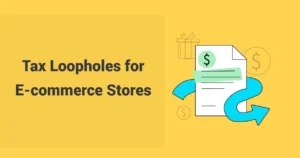Running an online store is fun—orders come in from Shopify, Amazon, or Etsy, and customers love your stuff. But tracking your money can feel like a mess. Confused about payouts, taxes, or profits? You’re not alone. Bad cash flow kills 82% of businesses. The good news? Ecommerce accounting and bookkeeping can help with finances, and tax reporting. This guide makes ecommerce accounting for small businesses simple with SAL Accounting’s help.
We’ll cover sales, taxes, and more with simple tips, examples, and tools to make your money easy to manage. Online sales will grow 22% this year, so now’s the time to get your finances right. Let’s start!
Quick Takeaways
- Ecommerce accounting tracks your store’s money—sales, fees, taxes, and more.
- It’s harder than regular accounting because of different platforms and tax rules.
- Reports like balance sheets, income statements, and cash flow show how your business is doing.
- A good system stops big mistakes, like missing taxes or wrong profits.
- Tools like QuickBooks or A2X make tracking easy and save time.
What Is Ecommerce Accounting?
Ecommerce accounting tracks all the money in your online store. This includes sales, refunds, fees, taxes, shipping, and chargebacks. Unlike a physical store, you deal with sales on multiple platforms, delayed payments, and taxes that change by location. It gives you clear reports:
- Balance sheet: What you own vs. what you owe.
- Income statement: Money you make minus costs.
- Cash flow statement: Money coming in and going out.
For example, a $100 Shopify sale might lose $3 to Stripe fees, and the money might take days to arrive. Ecommerce bookkeeping figures out your profit, fees, and taxes. About 86% of sellers find this hard. Mistakes add up without a good system. Check our tips on avoiding ecommerce accounting mistakes.
Why Ecommerce Accounting Matters for Small Businesses?
Ecommerce accounting for small business keeps your online store healthy. Here’s why it’s important in 2025:
See Your Profits
Know what you earn after fees, taxes, and costs. This helps you spend wisely on ads, products, or staff. Without it, 80% of new stores fail in 18 months.
Stay Safe
Good ecommerce tax reporting avoids fines—like $2,000 for tax mistakes. New 2025 rules are stricter. It also spots odd chargebacks or fraud.
Keep Cash Ready
Ensure you have money for inventory or slow months. Cash flow issues sink 82% of businesses. Ecommerce bookkeeping helps you plan.
Grow Your Store
Clear books make it easier to get loans or investors. One seller got funding by showing clean numbers.
Without ecommerce accounting, you’re guessing. That leads to money problems or missed chances. Start now to keep your store strong.
Read More: “Form W-8BEN Explained: A Complete 2025 Guide for Foreign Individuals”
How Ecommerce Accounting Is Different
Ecommerce accounting isn’t like regular accounting. It has unique challenges:
- Lots of Sales: Online stores can have hundreds or thousands of sales a month. A physical shop might have 50.
- Multiple Platforms: Selling on Amazon, Shopify, and Etsy means different fees (Amazon takes 15%, Etsy takes 6.5%), payouts, and returns.
- Delayed Money: You sell today, but Amazon might hold your cash for two weeks. This makes tracking hard.
- Tricky Taxes: Physical stores pay taxes where they are. Online stores pay taxes where customers are—anywhere.
- Fast Inventory Changes: Your stock moves quickly across platforms, unlike a single store’s shelves.
- Digital Payments: Payments have fees (Stripe takes 2.9% + 30 cents) and delays of days or weeks.
- Global Sales: Selling abroad means handling exchange rates and fees that cut profits.
For example, a $100 sale in a physical store is $100 profit (minus costs). Online, that $100 on Amazon might lose $15 to fees, $10 to taxes, $5 to a refund, and $2 to currency fees—leaving $68. Ecommerce accounting tracks what you keep.
5 Easy Steps to Master Ecommerce Bookkeeping
These five steps will help you manage your ecommerce finances. Let’s start with the first.
1. Set Up Your Ecommerce Bookkeeping System
E-commerce bookkeeping is the foundation of your online store’s finances—it tracks every dollar to save you time and avoid costly mistakes. Here’s how to set it up right in 2025.
Keep Money Separate
Get a business bank account and credit card. Don’t mix personal and business money. It’s a tax mess and could cause an IRS audit. You need:
- Checking account for daily use.
- Savings account (save 25-30% of profits for taxes).
- Credit card for business expenses.
Choose a Business Type
A sole proprietorship is simple but has fewer tax benefits. An LLC offers more protection. You can ask our tax experts about LLC incorporation and get more information.
Pick Software
Use QuickBooks Online or Xero. They connect to Shopify or Amazon and pull in sales automatically. One seller used A2X and cut ecommerce bookkeeping time in half.
Organize Your Money
Sort finances into categories. Here’s a sample chart of accounts:
| Category | Examples |
| Income | Sales, Refunds, Discounts |
| Expenses | Product costs (COGS), Platform Fees, Marketing, Shipping |
| Assets | Cash, Inventory, Money owed to you |
| Liabilities | Loans, Bills you owe |
| Equity | Your investment, Profits kept |
Track Sales
Use double-entry bookkeeping (each sale affects two accounts, like cash and revenue). Pick a method:
- Cash Basis: Record money when it moves. Good for new stores.
- Accrual Basis: Record sales when they happen, even if unpaid. Better for bigger stores.
Connect Software
Follow these steps to set up your software:
- Sign up for QuickBooks or Xero.
- Link your bank account safely.
- Connect Shopify or Amazon via their app store.
- Set tax rules for your state.
- Test by sorting a few sales (put sales in “Revenue”).
Set up your system now to keep your ecommerce finances clear. Need help? See our ecommerce bookkeeping services.
Pro Tip: Check accounts weekly to catch mistakes, like an Amazon payout that’s off.
2. Track Sales and Profits for Shopify and Amazon
Online sales get messy with fees, refunds, and delays. Here’s how to track them for accounting for Shopify and Amazon accounting:
Record Sales Right
Know what you actually make:
- Platforms take fees (Amazon’s 15%, Etsy’s 6.5%). A $500 sale might be $450.
- Count sales when they happen, not when paid (March 1 sale counts for March 1).
- Track returns separately. They can be 20% of sales. One seller used Xero and A2X to manage refunds, saving hours.
Handle Tough Stuff
For global sales, convert to your currency and track fees (2-4% of profits). Xero does this for you.
- Link Shopify or Amazon to QuickBooks. Over 12,000 businesses use A2X for this.
- Check platform reports monthly (like Amazon’s “Payments” tab). Match them to bank deposits. Our Amazon bookkeeping services can help.
Example: One seller thought they made $500 profit but kept $425 after fees and discounts. That mistake cost $15,000 in a year. They raised prices fast. Don’t let fees surprise you.
Pro Tip: Track discounts separately. Forgetting promotions can lose you money.
| Case Study: Shopify Seller’s $30,000 Profit GapThe Problem: Sarah’s jewelry business showed $200k in Shopify sales but her bank account told a different story. Stripe fees (2.9% + $0.30), returns (15% rate), and platform costs were eating $30,000 she didn’t know was missing. What We Did: Our Shopify accounting specialists connected A2X to her Shopify and QuickBooks to track real profits. We separated gross sales from actual deposits and calculated true margins—25%, not the 65% she thought. The Result: Sarah raised prices 20% and added return fees. Monthly profit jumped from $3,200 to $6,800. Now she sees exactly what hits her account after all fees. |
3. Calculate Product Costs (COGS) with Inventory Accounting
COGS is what you spend on products. Mess this up, and your prices won’t work. Good inventory accounting keeps profits strong.
Know Your Costs
Count everything that goes into your products.
COGS Breakdown:
Product cost: $20
+ Shipping: $5
+ Packaging: $2
+ Storage: $1
= Total COGS: $28
Pro Tip: Don’t include ads or rent. Those are business costs, not product costs. For bundles ($10 shirt + $5 hat = $15 COGS for $30 sale), split costs evenly.
Track and Use Data
- Find margins: $50 sale – $28 COGS = $22 profit (44% margin).
- Use Fishbowl to avoid overselling. One Etsy seller found hidden costs, raised prices, and increased profits 15%.
- Check monthly. Supplier costs change, so prices should too.
Pro Tip: Check COGS monthly. Rising supplier costs hurt margins if you miss them.
4. Handle Sales Tax for Online Stores
Sales tax for online stores is tricky. Rules vary by state, and mistakes cost big. One seller owed $15,000 for missing registrations. Here’s how to do ecommerce tax reporting right in 2025:
Know Where You Owe Tax
Most sellers don’t realize they owe tax in multiple states until it’s too late. You owe tax in states where you hit $100,000 OR 200 sales in most states. California’s limit is $500,000.
Examples:
Scenario A: $120,000 sales + 150 transactions = Nexus ✓
Scenario B: $80,000 sales + 250 transactions = Nexus ✓
Scenario C: $80,000 sales + 150 transactions = No nexus
Amazon and Etsy handle marketplace taxes. You still file Form 1099-K for ecommerce platforms.
Set Up Your System
Register in needed states via tax portals (takes 1-2 weeks), then use TaxJar to figure out rates for 10,000+ tax jurisdictions. Automate filing with TaxJar or Avalara for quarterly or yearly reports. For global sales, use Avalara for VAT/GST or contact our tax experts.
Pro Tip: Monitor tax thresholds to avoid surprises in new states.
| Case Study: Amazon Seller Fixes $18,000 Tax ProblemThe Problem: Mike’s $400k Amazon business triggered nexus in 8 states through FBA storage, but he only registered in Texas. California wanted $18,000 in back taxes plus penalties. What We Did: SAL Accounting registered him in all required states and set up TaxJar for automatic tax collection. We negotiated with California showing good faith compliance efforts. The Result: Settled for $3,200 instead of $18,000. TaxJar now handles multi-state compliance automatically while preventing future violations. |
Read more: “Amazon Tax Guide for Canada and U.S.: Sales Tax, Income Tax, and Deductions“
5. Keep Cash Flow Strong
Profits don’t mean cash in hand. Here’s how to keep your ecommerce finances steady in 2025:
Track Cash
Watch your money:
- Use QuickBooks to watch sales and costs. Cash flow reports show what’s available.
- Try Float to plan for slow months or big buys. One Amazon seller saved 20% of peak cash.
Plan for Ups and Downs
Sales can drop 30% in slow months. Save a quarter of peak cash.Also keep 3-6 months of costs as backup.
Improve Cash Flow
Smart moves to keep cash flowing smoothly:
- Use Fishbowl to cut extra stock. One WooCommerce store freed 30% of cash.
- Ask suppliers for 60-day payment terms, not 30.
- Pay suppliers on time via QuickBooks.
- Plan for delays: Stripe (7-14 days), Amazon (14-30 days + 5-10% reserves).
One Etsy shop saved $5,000 for a slow quarter and bought inventory without loans. Keep cash steady to stay strong.
Pro Tip: Save 10-15% of sales for taxes and emergencies. Payout delays can hurt if you ignore them.
Top Ecommerce Accounting Software in 2025
Good tools make ecommerce accounting simple. Here’s a quick comparison of ecommerce accounting software 2025:
| Tool | Price | Features | Best For | Pros | Cons |
| QuickBooks | $25/month | Syncs platforms, reports, payroll | Growing stores ($100k-$500k) | Strong, good support | Costs more |
| Xero | $15/month | Multi-currency, dashboards, sync | Small stores (under $100k) | Easy, cheap | Weak payroll |
| A2X | $19/month | Amazon/Shopify reconciliation | Multi-platform sellers | Saves time | Limited focus |
| Finaloop | Custom | AI-driven, real-time, SKU tracking | Hands-off ($500k+) | Built for ecommerce | Pricing unclear |
| Wave | Free | Basic bookkeeping, invoicing | Startups (under $50k) | Free | Not for big stores |
| Avalara | Varies | Sales tax automation, global | Complex tax needs | Great for compliance | Better as add-on |
To connect QuickBooks with Shopify:
- Find “QuickBooks” in Shopify’s app store.
- Install and log in.
- Map accounts (sales to “Revenue,” fees to “Expenses”).
- Set sync to daily or weekly.
Other platforms work the same—find the app, connect, and you’re set.
Read more: “Best eCommerce Accounting Software in 2025: Top Picks for Online Sellers“
Stay on Top with Financial Reporting for Online Sellers
Keep your ecommerce finances in check with these 2025 tips for financial reporting for online sellers:
- Use Automation: A2X or Finaloop handle sales, taxes, and stock. One Etsy seller saved 10 hours a week with AI.
- Check Monthly: Match bank statements to platform payouts. Look for odd fees or chargebacks.
- Fix Taxes Early: Use TaxJar or a tax pro. 2025 tax laws are tougher.
- Start Small: Use Wave for tiny stores. Get an accountant at $100k or multi-state sales.
- Watch Numbers: Check profit margins and cash monthly. Aim for 30% margins.
- Back Up Data: Save financials weekly to Google Drive with two-factor security. Add fraud alerts to bank accounts.
Pro Tip: Set goals (like 30% margins) and check them monthly.
Final Thoughts
Ecommerce accounting makes your store strong. What is ecommerce accounting? It’s tracking every dollar to avoid errors. Use tools like QuickBooks or TaxJar to master ecommerce bookkeeping, ecommerce finances, and ecommerce tax reporting. For ecommerce accounting for small business, accounting for Shopify, Amazon accounting, or financial reporting for online sellers, our experts keep your money smooth. Start easy: open a business account, try Wave, or sort sales tax for online stores. Contact us if you want to keep your money clean!
Frequently Asked Questions
It tracks your online store’s money—sales, taxes, stock, and cash. It’s harder than regular accounting due to platforms and tax rules.
Online stores have lots of sales, platform fees, and taxes based on customer locations, unlike simple physical shops.
It handles digital payments, fees, and returns. You need tools that sync with sales platforms.
Track product costs, shipping, packaging, fees, ads, and business expenses for clear profits.
QuickBooks, Xero, A2X, Finaloop, and Wave are good. They sync platforms and automate tasks.
Use TaxJar to calculate and file taxes. Check where you owe tax. Amazon handles marketplace taxes, but you manage website sales.
Yes! A2X and Finaloop sync sales, taxes, and stock, saving time.
Software helps, but an accountant is great for taxes and complex rules, especially with multi-state sales.
Use A2X to align sales with deposits. Connect to QuickBooks and check monthly. Fix errors with settlement reports.
Inventory affects costs and cash. Tools like Fishbowl keep stock accurate for better profits.
Track VAT/GST (like 20% UK VAT). Use Avalara for compliance. Convert currencies in Xero. Register for taxes in high-sales countries.






